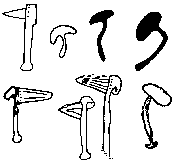The Mind in the Cave

Shamanism, Caves and France
By Sally Gosheron,
Atelier de la Rose
How do you begin to explain the truly fabulous images found in prehistoric caves in the Lot and Dordogne regions of France? Why are only certain animals drawn and not others? What is the meaning of giant spotted horses and negative handprints?
Theories that explain the cave images in terms of religion have been proposed by several academics. One of the most recent attempts has been made by a leading French prehistorian, Jean Clottes. He collaborates with people of other academic disciplines in his search to understand the mysterious marks. Clottes' work uses areas of anthropology and neuropsychology to propose that the prehistoric images are the product of a shaman culture (or a succession of shaman cultures).
His theory is speculative, like all the others, but it is one that is highly informed and well argued. He has published his ideas in a book, co-written with David Lewis-Williams, called Les Chamanes de la Préhistoire (The Shamans of Prehistory). Lewis-Williams is an archeologist and anthropologist whose specialist area of study is the San people of South Africa and their shaman belief system.
Our ancestors were hunter-gatherers. Shamanism is most often associated with such cultures in the contemporary world. Nevertheless one cannot blithely transpose modern cultures onto prehistoric ones, which is why Clottes also draws on other disciplines and an analysis of the prehistoric images themselves to provide more convincing links between the ancient and the modern.
Prehistorians do not know how to interpret these marks. Clottes' and Lewis-Williams' book offers an answer. As shamans, of whatever period of history, have the same biological brain as everyone else the study of the brain's functions is relevant and revealing. When one goes into a trance, however this is induced (by sensory deprivation, fasting, intense pain, certain illnesses, drugs or prolonged, rhythmic percussion or dance) one encounters several levels of hallucinations. The initial stage is one of abstract signs: dots, zigzags, grids or a composition of straight and curved lines. At a deeper level of trance one can encounter animals and even seem to become one.
These different levels of hallucinations are universal, although the details of the experience may vary according to the social or cultural background of the subject. Dots, grids and other abstract marks occur in many caves. According to these ideas the spotted horses may well represent several stages of the trance experience.
***********************************************
Please visit the above link to read the whole article.
 the world is what we make it
the world is what we make it























0 Comments:
Post a Comment
<< Home